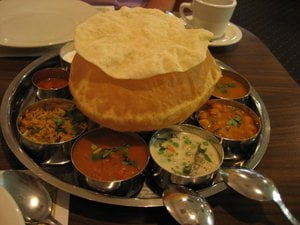I am pretty well-versed in Indian cuisine. But I have to admit that I was completely unfamiliar with the following delicacies from the state of Maharashtra before an Indian acquantance described them for me:
1. Wada-Pav
This is a fast-food snack. It consists of a spicy, deep fried potato based patty (called the “Wada”) sandwiched between a thick square of bread that is similar to a burger bun (called the “Pav”). Thus the name Wada-Pav. This dish is usually served with sweet & sour sauces called “chutney” and fried salted green chilies.
Wada pav is popular only in the state of Maharashtra, and not so well known in the rest of India. It is the preferred breakfast or noon-time snack for the masses and is sometimes had even for a main meal. Its popularity stems from the fact that it is very economical, filling and easily available. In a city like Pune or Mumbai there are numerous wada-pav stalls and no matter where you may be in the city, you can always find one just around the corner.
2. Kanda Pohe
Poha or Pohe is the name given to rice which is flattened by beating. Pohe is a popular dish all over India and is usually a breakfast item. In Maharashtra however, Pohe is prepared in a different way from the rest of the country. The difference is that lots of onions are added during the cooking. Onions are known in Marathi as “Kanda.” Hence the name Kanda-Pohe. This style of preparation leads to the Pohe having a flavor and aroma that is unique to this region and hence a specialty food of Maharashtra. Pohe is available at a number of breakfast stalls all over the city of Pune and even in some of the restaurants that operate at breakfast times.
3. Pitla Bhakri
Pitla Bhakri is a rural food of Maharashtra, the staple food amongst the farmers and village folk. It forms part of the typical Maharashtrian cuisine and has in the last two decades become quite popular amongst the more cosmopolitan city dwellers as well. It consists of “Pitla,” a pasty-looking dish prepared from the powdered version of “Dal,” a popular pulse. Pitla is usually eaten with “Bhakri,” a bread made from either “Jowar” or “Bajra,” both of which are cereals. Pitla Bhakri can be enjoyed in Pune at one of the select restaurants serving typical Maharashtrian cuisine.
4. Bharit Bhakri
“Bharit” is another dish enjoyed with the same kind of bread called “Bhakri” mentioned earlier. Bharit is prepared by roasting and then mashing a particular variety of large Brinjal (Eggplant). Thereafter spices, seasoning, chopped onions and tomatoes are added. Bharit Bhakri is quite typically a Maharashtrian cuisine and usually available in the same restaurants as Pitla Bhakri.
5. Sabudana khichdi
Sabudana” is a local food base prepared from the latex of a particular plant. The name given to it by the English is “Sago.” Sabudana is white in color and granular in texture. The grains are globular in shape and look somewhat like the tiny thermocol balls used for packaging delicate materials. The ready-to-eat dish prepared from it is known as “Khichdi,” which roughly mean “mixture.” Sabudana Khichdi is a popular breakfast item and is one of the few food products that are allowed to be eaten when Maharashtrians undertake holy-fasting known in Marathi as “Upaas.
While all of these dishes are available in restaurants and food stalls in Maharashtra, the best way to experience them is in a Maharashtrian home. One may also notice that all of these dishes are vegetarian. Although fish and poultry do form a part of the diet of roughly half of all Pune residents, the most popular dishes remain the above-mentioned vegetarian ones.Bharit” is another dish enjoyed with the same kind of bread called “Bhakri” mentioned earlier. Bharit is prepared by roasting and then mashing a particular variety of large Brinjal (Eggplant). Thereafter spices, seasoning, chopped onions and tomatoes are added. Bharit Bhakri is quite typically a Maharashtrian cuisine and usually available in the same restaurants as Pitla Bhakri.






